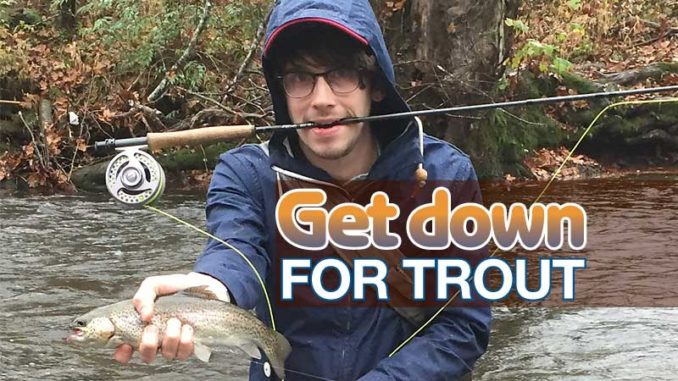
Purists love dry-fly fishing for mountain trout, but for consistent catches, go deep with nymphs
A large, dark shadow was visible in a bathtub-sized pool during a winter trout trip. The pool downstream from where I stood had produced several average-sized rainbow trout for quick release. The shadow was in a tiny pool upstream in the middle of a turbulent riffle.
The fly was a black, No. 16, stonefly nymph with a split shot pinched onto the leader 6 inches above the fly. After repositioning, a diagonal cast upstream dropped the fly several feet above the shadow, which allowed the fly to enter the pool without the line first passing over the fish.
As soon as the fly entered the pool, a strike was felt. A quick hookset and a brief struggle brought a 12-inch rainbow to the net and a quick release. This fish definitely had not created the shadow in the pool.
After allowing the pool to rest, the fly was cast again above the pool. In a repeat of the previous scenario, a strike was quick to follow, but this time it was different; it was the fish that had created the shadow. He fought valiantly but was being drawn closer to the net. He made one last run toward brush in the lower pool, and I increased the pressure to turn him. As fate would have it, the hook pulled free. I muttered to myself, “I only wanted a photo”.
Trout spend most of their lives near the bottom
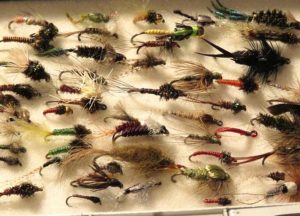
The location was the North Mills River in western North Carolina, and this fish was likely a brood fish that had been released into the stream. It appeared to be at least 24 inches or better and at one point was only feet away. The brilliant color and black dots on his scales were vivid in the light that filtered through the overhanging tree branches.
This kind of action is not uncommon if you learn to fish nymphs for winter trout. It is no secret that the greatest part of a trout’s life is spent near the bottom of a stream. Except in the case of a significant hatch, dry-fly fishing will not produce similar results.
Everyone loves to catch trout on dry flies, and nothing compares with a splashy rise to a well-cast dry fly, but when the winter doldrums kick in, going deep with nymphs is the ticket for winter trout action. Also, the fish will usually average much larger.
There are two techniques for nymphing: fishing with an indicator or high-sticking. I like to stay in contact during the drift and do not feel it is possible with an indicator. The only exception is when the fish are rising a long cast away. This may happen on large water, and I remember catching large cutthroat trout on the Yellowstone River that would have been impossible without indicators.
The high stick
The “high stick” technique is the best strategy, especially on small streams. When properly executed, it will maintain direct contact with the fly. The procedure is to cast diagonally upstream, beyond the target area. Allow the nymph to settle to the bottom (use adequate split shot or bead-head flies). As the drift progresses and the fly draws nearer to the rod, lift the rod to maintain contact. As it passes, lower the rod tip to extend the drift. Watch the point where the line enters the water and any unusual movement or line stopping should elicit a hook-set.
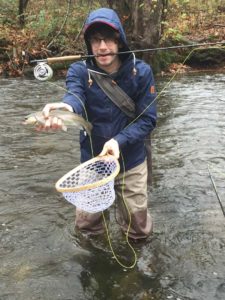 Everyone has favorite flies, and any list is sure to be argumentative. My biggest trout have responded to black stonefly nymphs, but gold-ribbed hare’s ear, prince, brown hackle peacock, deep sparkle pupa, pheasant tail, mosquito larva and midge emerger are equally successful at times. The ability to tie your own flies is a plus, as you can match the local insect life and are not limited to a few basic patterns.
Everyone has favorite flies, and any list is sure to be argumentative. My biggest trout have responded to black stonefly nymphs, but gold-ribbed hare’s ear, prince, brown hackle peacock, deep sparkle pupa, pheasant tail, mosquito larva and midge emerger are equally successful at times. The ability to tie your own flies is a plus, as you can match the local insect life and are not limited to a few basic patterns.
Matching insect life is important, but having the exact pattern will not assure success. If the presentation is incorrect, you will consistently fail to catch fish. It is critical to get the fly to the bottom of the stream. If you are not hanging on rocks or brush, you are not fishing deep enough. The fly or split shot should tick along the bottom where the big boys are holding. If the pool is 6 feet deep and you are fishing at a depth of 3 feet, you are not likely to consistently catch fish.
Make things easy on the trout
In cold weather, trout cannot afford the effort of moving up in the water column to chase a fly. The drift must present the fly where the trout can take it with minimal effort.
If you are fishing a hatchery supported stream, egg patterns fished like nymphs will catch a lot of fish. The San Juan Worm is another sub-surface fly that is questionable to some. They are good options at times. This is a decision for the individual, and purists may choose not to use these patterns.
A good strategy for winter fly fishing is to nymph fish, but be prepared to change to dry flies if you see rising trout. This is the best of both worlds. You can catch fish holding near the bottom with nymphs, but if a hatch occurs, you can take advantage with dry flies. It is pointless to pound the water to a froth with a dry fly if a hatch is not occurring. You may pick up a fish occasionally, but nymphing will be much more productive. If you have not tried nymphing, you are missing a sure-fire method of catching more trout.
 “High stick” technique
“High stick” technique
Angler casts well above fish, keeps rod tip down as nymph falls to bottom of streambed.
As nymph bumps downstream, angler continually raises rod tip to take up slack line and keep nymph on bottom in front of trout.
As nymph passes fish, angler lowers rod tip to allow nymph to drag along bottom going downstream in case other trout are present in tail of pool.
Recognizing productive water
Choosing where to fish is as important as your fly selection; fishermen need to learn to “read the water.”
If there is a large, submerged rock, the current will usually bulge over the top of it. Even a pool that appears featureless will have some bottom contours that will hold most of the fish. A couple of drifts will alert you to the features of the pool.
It is vital to note that structure in the water affects the velocity. This also applies to the bottom contours. A slight dip in the bottom will often allow the swifter current to pass over it and provide a safe haven for trout. From there, they can move slightly into the swifter water to take an insect but can quickly drop back into the slower water to conserve energy.
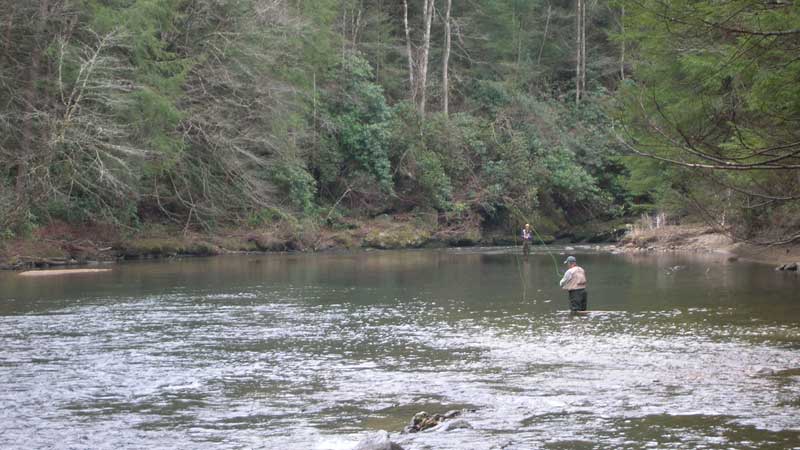
Casting upstream from these features will allow the weighted fly to drop to the level where the fish is holding by the time it reaches it. Failure to cast far enough above the contours or other features will result in a fruitless drift and give the impression that no fish are present. This is a common error among novice anglers and one that bears stressing.
Short, heavy leaders are helpful
Nymphing can be demanding and very tiring. Holding the rod high when “high sticking” places a strain on the shoulders and back. A day on the water chasing winter trout will be demanding when nymphing. But it is well worth the investment of effort.
Due to the subsurface nature of fishing with nymphs, heavier and shorter leaders may be used. This will be an advantage when playing and landing the larger trout that this method will yield. It is possible to fish two nymphs of different patterns, but may result in some tangles. If you choose to do this, once you see that one fly is more productive, you may choose to use only that pattern.

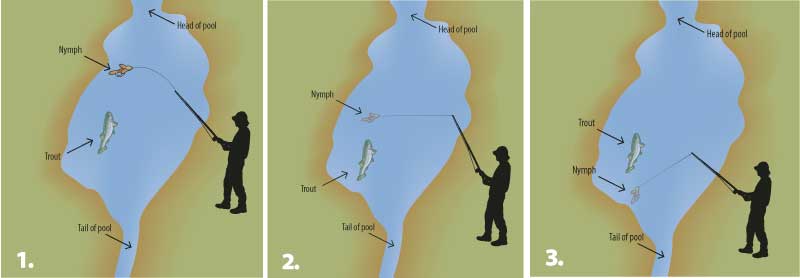
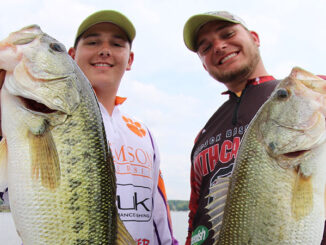
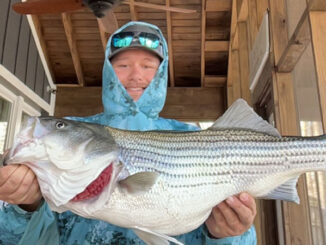
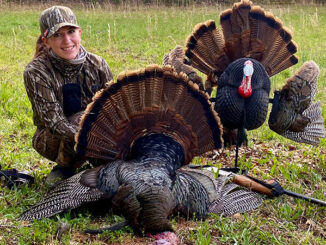
Be the first to comment